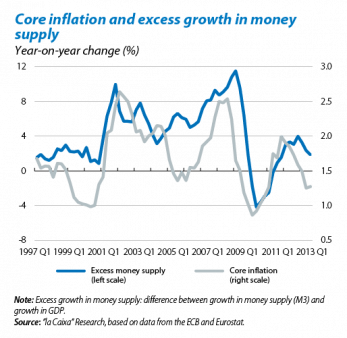As Milton Friedman once said: «Inflation is always and everywhere a monetary phenomenon». Let us therefore analyse, from this perspective, the recent developments in inflation and the possible risks of it remaining at excessively low levels for some time.
According to the quantity theory of money, prices vary in proportion to the money supply. This relationship is based on the premise that the value of the transactions carried out in an economy is equal to the quantity of money existing in that economy multiplied by the number of times that money changes hands (what we call the velocity of money).(1) Assuming the velocity of money is relatively constant, growth in money supply in line with growth in economic
activity implies price stability. On the other hand, if the money supply grows more quickly than economic activity, this generates an upward pressure on prices, i.e. inflation.
The first graph shows the historical trend in the euro area of the money supply variation (M3) not backed by economic growth (the difference between money supply and GDP growth) and core inflation. As can be seen, there does seem to be some positive relationship between both variables in the long term. The contemporary correlation is slightly above 60%. However, in the short term, and temporarily, the relationship between both variables can weaken if other factors come into play. The velocity of money, for example, tends to fluctuate throughout the economic cycle. At times of high uncertainty, when preferences for savings and liquidity can suddenly get stronger, the velocity of money decreases and the money supply can grow without this necessarily resulting in price rises in the short term.
Within the current context, with inflation at relatively low levels and very few signs of any upward trend starting for the present, the recent downward trend in money supply is not encouraging.
Part of this drop in the growth rate of money supply is due to less liquidity in the system. As the economic recovery has gradually consolidated over the last few quarters, financial institutions have reduced the relaxed liquidity positions they had accumulated at the peaks of the crisis due to precaution. This rapid fall in excess liquidity is also due to the reduction in bank reserves. Banks accelerated the rate they paid back their LTRO loans to face the Asset Quality Review to be carried out by the European Central Bank this year. In fact, this rapid reduction in liquidity produced some upswings in the EONIA at the end of December 2013. The ECB must therefore remain very alert and take further action if the current situation becomes entrenched. An excessively low inflation rate hinders deleveraging and makes it more difficult for periphery countries to continue to gain competitiveness through price and wage containment.
(1) M x V = P x Y or dM + dV = dP + dY. Where M is money supply (dM are the variations in this variable), V is the velocity of money, P are prices and Y is GDP in real terms.

